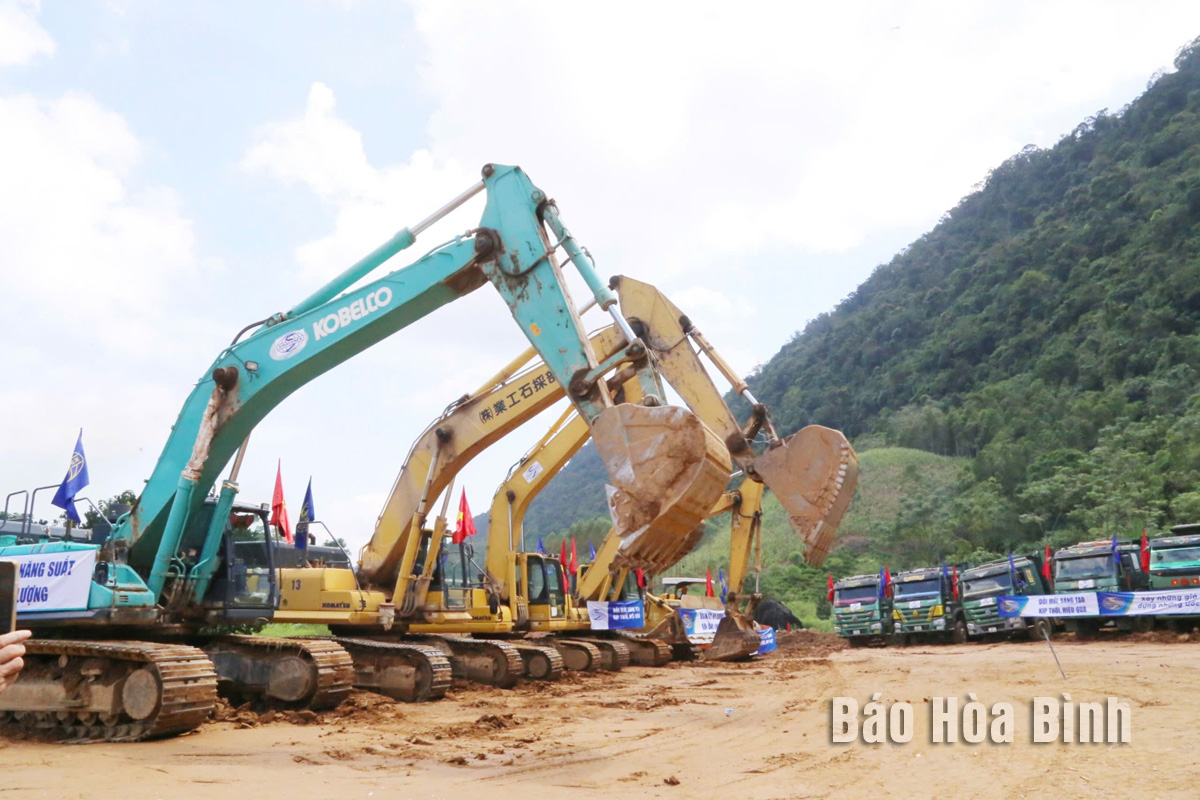
People in the mountainous district of Da Bac, the northern province of Hoa Binh, were eager to attend the groundbreaking ceremony of Hoa Binh - Moc Chau Expressway – the biggest transport project in the province so far.
Machines and vehicles
are at the construction site of the XL-01 package, which is the section
fromKm19+000 to Km40+750, in the Hoa Binh - Moc Chau Expressway project.
Flags and banners celebrating the groundbreaking ceremony were seen along part
of Provincial Road 433, an artery of Da Bac district, in Da Bac town. Road
signs and local authorities showed delegates to Xeo hamlet in Cao Son commune,
where the ceremony was held.
The 80-year-old Quach Thi In travelled more than 10km from Da Bac town’s Tay
Mang zone to Xeo hamlet to attend the ceremony. She said born and raised in the
highlands of Da Bac, people of her generation are familiar with tough roads
that run through forests and mountains.
Many of them have never known what an expressway is, In said, adding that she
was very excited to see the expressway construction started.
Nguyen Van Dong, a local resident, said that his family has donated over 1,400
sq.m of agricultural land to make room for the construction of the expressway.
Over the past time, the local Party committee and administration helped his
family understand the significance of this project, so he agreed to hand over
the land. Dong said that he hopes the project will be implemented on schedule,
opening up a bright future for the rural areas that the road passes, including
his hometown - Cao Son commune.
The groundbreaking ceremony of Hoa Binh - Moc Chau Expressway was held on
September 29, marking a remarkable milestone in the infrastructure development
of the northwestern region in general and Hoa Binh province in particular.
It saw the participation of leaders of the State, ministries and central
sectors, representatives of provincial and district departments and agencies,
along with hundreds of locals.
Speaking at the event, Deputy Secretary of the provincial Party Committee and
Chairman of the provincial People's Committee Bui Van Khanh emphasised that Hoa
Binh - Moc Chau Expressway is expected to attract investment to the localities
it traverses.
The expressway is a key transport project, the first of its kind in Hoa Binh
province, and also the largest ever co-implemented by the province. It is of
great significance as once it is open to traffic, National Highway 6 will no
longer be the only road that runs through Hoa Binh to connect Hanoi with
provinces in the northwestern region.
Besides, Hoa Binh - Moc Chau Expressway is set to help reduce traffic
congestion, improve the capacity of regional transport infrastructure, and
create a driving force to attract investment for economic development.
After the groundbreaking ceremony, contractors started work on the Km19+000 -
Km40+750 section with "great efforts, strong determination, and drastic
actions" as directed by Prime Minister Pham Minh Chinh at the ceremony.
Hoa Binh province is undergoing a dynamic transformation amid Vietnam’s national digital transition. Building on Poliburo’s Resolution No. 57-NQ/TW on breakthroughs in science, technology, innovation, and national digital transformation, the province has rolled out a wide range of practical action plans. A standout initiative is the "Digital Literacy for All” movement, an effort to ensure that no one is left behind in the digital era.
Hoa Binh province is undergoing a dynamic transformation in the wake of the national digital transformation movement. Building on Resolution No. 57-NQ/TW of the Politburo on breakthroughs in science, technology, innovation, and national digital transformation, the province has implemented a wide range of practical action plans. A standout initiative is the "Digital Literacy for All” movement ambitious effort to ensure that no one is left behind in the digital age.
With a spirit of unity and proactive problem-solving, the Party Committee, the government and the people of Dong Lai Commune (Tan Lac District) have made great strides in implementing the resolutions of the 24th Party Congress of the commune for the 2020 - 2025 term. Focusing on leadership and practical actions, the commune has brought the Party’s resolutions into daily life, creating strong impacts and pushing the local development forward.
Amid the nationwide push for digital transformation, young people in Hoa Binh Province are stepping up as dynamic pioneers, applying technology to enhance Youth Union operations and expand the reach of youth-led initiatives. Through creativity and adaptability, Youth Union organizations at all levels have introduced a series of practical solutions, contributing to modern governance and community development.
In recent years, An Nghia commune, located in Lac Son district, has stepped up administrative reform, focusing on improving the quality and efficiency of its single-window service unit for receiving and processing administrative procedures. These improvements have helped create favourable conditions for local residents and organisations to handle administrative procedures, contributing to the commune’s broader socio-economic development.
The Prime Minister-approved master plan to develop the multi-use value of forests ecosystems through 2030, with a vision to 2050, aims to improve the management and sustainable use of forest resources, create jobs, increase incomes, and improve the living standards of ethnic minorities, people in mountainous and remote areas, forest workers and those living near forests.



